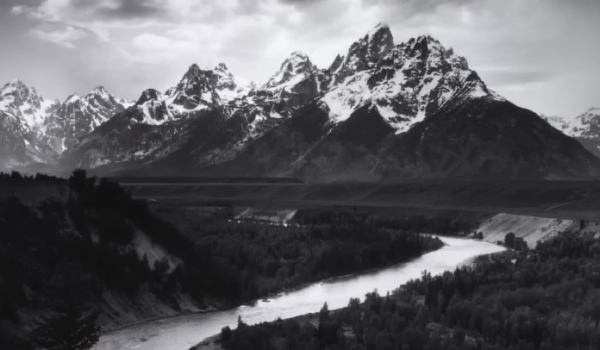Among the realm of famous photographers, one name remains synonymous with the concept of straight photography: Ansel Adams. Born in San Francisco in 1902, Adams’s passion for photography flourished at a young age. Known for his meticulous and visually arresting images of the American West’s natural landscapes, Adams was a relentless advocate of straight photography, the technique of creating images that have not been manipulated, either in the camera or in the darkroom.
Straight photography, a trend that took root in the late 19th and early 20th centuries, called for the truthful and objective representation of the world. Unlike its predecessor, pictorialism, which embraced the use of soft focus, special filters, and elaborate darkroom processes to create images that resembled paintings, straight photography focused on capturing the world ‘as is’. It emphasized sharp focus, high detail, and the careful use of light and shadow.
Ansel Adams and His Signature Style
Ansel Adams, the world-renowned landscape photographer, used his keen eye and technical prowess to capture some of the most iconic images of the American West. His signature style, defined by exquisite tonal range, sharp focus, and grand natural subjects, continues to inspire and captivate photographers and art enthusiasts worldwide.
The Sharpness of Adams’s Photography
Key to understanding Adams’s signature style is appreciating the sharpness of his images. In the era when soft focus and pictorialism were gaining popularity, Adams insisted on retaining clarity and precision in his work. This commitment to sharpness allowed him to capture the minutiae of nature and draw attention to the often overlooked details of his subjects.
- Image Sharpness: Adams’s photos are renowned for their incredible detail. Using large format cameras, he meticulously composed his images, which could resolve the finest of details, from the texture of a rock to individual blades of grass. The importance of this sharpness was not just in the detail but also in the context it provided to the grand scenes he captured;
- Depth of Field: Adams’s use of sharp focus is also seen in his masterful control of depth of field. His images are not limited to sharp subjects against a blurred background. Instead, they often exhibit sharpness across the entire depth of field, from the foreground to the background, giving his landscape photos a sense of grandeur and depth.
The Art of Grayscale: Tones and Contrasts
Working primarily in black and white, Adams transformed the grayscale medium into an art form. By eschewing color, he presented his subjects in a manner that emphasized tone, contrast, and texture over hue.
- Monochrome Palette: Adams believed that color could be distracting in images, so he chose to work primarily in black and white. This monochrome palette allowed him to focus on the intensity of light and the tonal contrasts that brought life to his subjects;
- Control of Tones: His grayscale images feature a wide tonal range, from the deepest blacks to the brightest whites. It’s in this realm that Adams truly showcased his technical mastery. His control of tones added depth and texture to his images, turning seemingly simple landscapes into dramatic scenes.
Nature as a Muse: The Focus on Landscapes
A key component of Adams’s work was his love of the natural world. His choice of subject matter largely revolved around the American wilderness, particularly its national parks.
- Love for the Outdoors: Adams’s love for the outdoors is evident in his work. His most famous photographs capture grand vistas in all their glory, from the snow-capped peaks of the Sierra Nevada to the expansive plains of New Mexico;
- Environmental Activism: Adams was not only a photographer but also a passionate environmentalist. His work was instrumental in promoting the preservation of natural landscapes, and many of his photos were used in environmental campaigns. His profound respect for the natural world transcended into his photography, turning his images into powerful tools for conservation.
Mastering Light with the Zone System
Perhaps one of the most significant contributions that Adams made to the world of photography is the Zone System. This technique, developed in collaboration with fellow photographer Fred Archer, became a cornerstone of his work and an essential tool for photographers seeking precision and control over their images.
| Term | Description |
|---|---|
| Tonal Control | The Zone System provides photographers with a way to precisely control the tonal range in a photograph. The system divides the tonal range into eleven zones (from 0 to X), with 0 representing pure black and X representing pure white. This method allows photographers to visualize and manipulate the tones in their images accurately. |
| Previsualization | An integral aspect of the Zone System is the concept of previsualization. Adams insisted on the importance of imagining the final print before releasing the shutter. This approach required a deep understanding of how different elements of a scene would translate into grayscale and how they would appear in the final print. It was through this methodical approach to photography that Adams was able to produce images with extraordinary tonal control and detail. |
Ansel Adams: Legacy and Influence

Ansel Adams, one of the most renowned photographers of the twentieth century, is celebrated not only for his striking black and white images of the American landscape but also for his unwavering commitment to the principles of straight photography. As an artist, educator, and advocate, his significant influence continues to reverberate in contemporary photography. This article examines the multifaceted legacy of Ansel Adams and how he continues to inspire and shape the photographic world.
Group f/64: The Advocacy for Straight Photography
During the early 20th century, the field of photography was largely dominated by pictorialism, an approach that emphasized manipulated, painterly aesthetics. Adams, a strong proponent of straight photography, sought to redefine the photographic paradigm.
- Formation of Group f/64: In 1932, Adams co-founded Group f/64, named after the smallest aperture setting on a large-format camera, which yields the sharpest focus. The group, which included Edward Weston and Imogen Cunningham among its founding members, propagated a new vision for photography, pushing against the prevailing pictorialist approach;
- Group f/64 Manifesto: The group’s manifesto emphasized “pure photography”, an approach that valued sharp focus, high contrast, and the exploration of tonal range. Their commitment to these principles played a crucial role in shaping the trajectory of 20th-century photography and establishing straight photography as a respected art form.
Adams as an Educator: Spreading the Gospel of Photography
Adams’s impact on photography was not limited to his role as an artist. He was also a dedicated educator who aimed to share his knowledge, passion, and vision with others.
- Teaching and Writing: Adams held numerous workshops, penned several instructional books on photography techniques, and taught at the San Francisco Art Institute. His works like ‘The Camera’, ‘The Negative’, and ‘The Print’ are considered seminal texts in the field;
- Developing the Zone System: Alongside Fred Archer, Adams developed the Zone System, a technique that allowed photographers to precisely control the tonal range in their images. This technique, although complex, became a cornerstone of photographic education and is still taught in classes worldwide.
Adams’s Influence on Environmental Conservation
Adams’s work went beyond the artistic realm and played a significant role in the field of environmental conservation. His stunning depictions of the American landscape were not only visually pleasing but also politically impactful.
- Nature Advocacy through Art: Adams’s photographs, like those of Yosemite and the Sierra Nevada, showcased the grandeur of America’s wilderness. These breathtaking images were instrumental in promoting environmental conservation and national parks;
- Role in the Sierra Club: Adams was an active member and served as a director of the Sierra Club, an environmental organization. His images were utilized in numerous conservation campaigns, reflecting his deep-seated belief in environmental preservation.
Adams’s Legacy in Modern Photography
Adams’s legacy continues to resonate in contemporary photography, inspiring countless photographers to follow his path in terms of technique, subject matter, and advocacy.
| Topic | Description |
|---|---|
| Influence on Modern Landscape Photography | Adams’s style, particularly his high-contrast, sharply focused landscapes, has profoundly influenced modern landscape photographers. His emphasis on capturing the splendor and dignity of nature remains a common thread in today’s landscape photography. |
| Techniques in Contemporary Use | Adams’s techniques, especially the Zone System, have been incorporated into the digital age. Modern tools like histogram displays and image editing software allow for precise control over tonality, mirroring the principles of the Zone System. |
| Inspiration for Environmental Photography | Adams’s use of photography as an environmental advocacy tool has inspired a new genre of photographers who use their work to highlight environmental issues and promote conservation. |
Ansel Adams and His Work: A Closer Look

For a better understanding of Ansel Adams’s application of straight photography, let’s take a closer look at his iconic piece, “Moonrise, Hernandez, New Mexico.”
The photograph shows a moon rising above a darkened town with a snow-capped mountain range in the background. The church and graveyard are illuminated by the last light of the setting sun.
- Light and Shadow: Adams skillfully manipulates the fading natural light to highlight certain elements in the photograph. The gravestones glow against the darkness, drawing attention to the foreground;
- Sharp Focus: The entire photograph, from the gravestones in the foreground to the mountains in the distance, is in sharp focus, a key characteristic of straight photography;
- Tonal Range: Adams uses his Zone System to perfectly balance the tonal range in the photograph. The contrasting tones between the dark foreground and the illuminated gravestones add depth and drama to the image.
For a more detailed analysis of Ansel Adams’s work and his approach to straight photography, check this video:
Conclusion
Ansel Adams’s commitment to straight photography has not only shaped his stunning body of work but has also significantly influenced the field of photography. Through his masterful use of technique, his influence on his peers, and his legacy as an educator, Adams stands as an undeniable testament to the power and potential of straight photography.
FAQ
Ansel Adams’s body of work epitomizes the principles of straight photography: sharp focus, high detail, and minimal post-processing. His consistent commitment to these principles and his efforts to teach and advocate for them make him an icon of straight photography.
The Zone System is a technique developed by Ansel Adams and Fred Archer. It allows photographers to control and predict the tonal range in their photographs, ensuring the accurate reproduction of the scene as visualized.
Ansel Adams’s work has significantly influenced modern photography. His techniques and methods, particularly the Zone System, are still taught in photography classes worldwide. His images serve as a source of inspiration for photographers interested in landscapes and nature photography.
